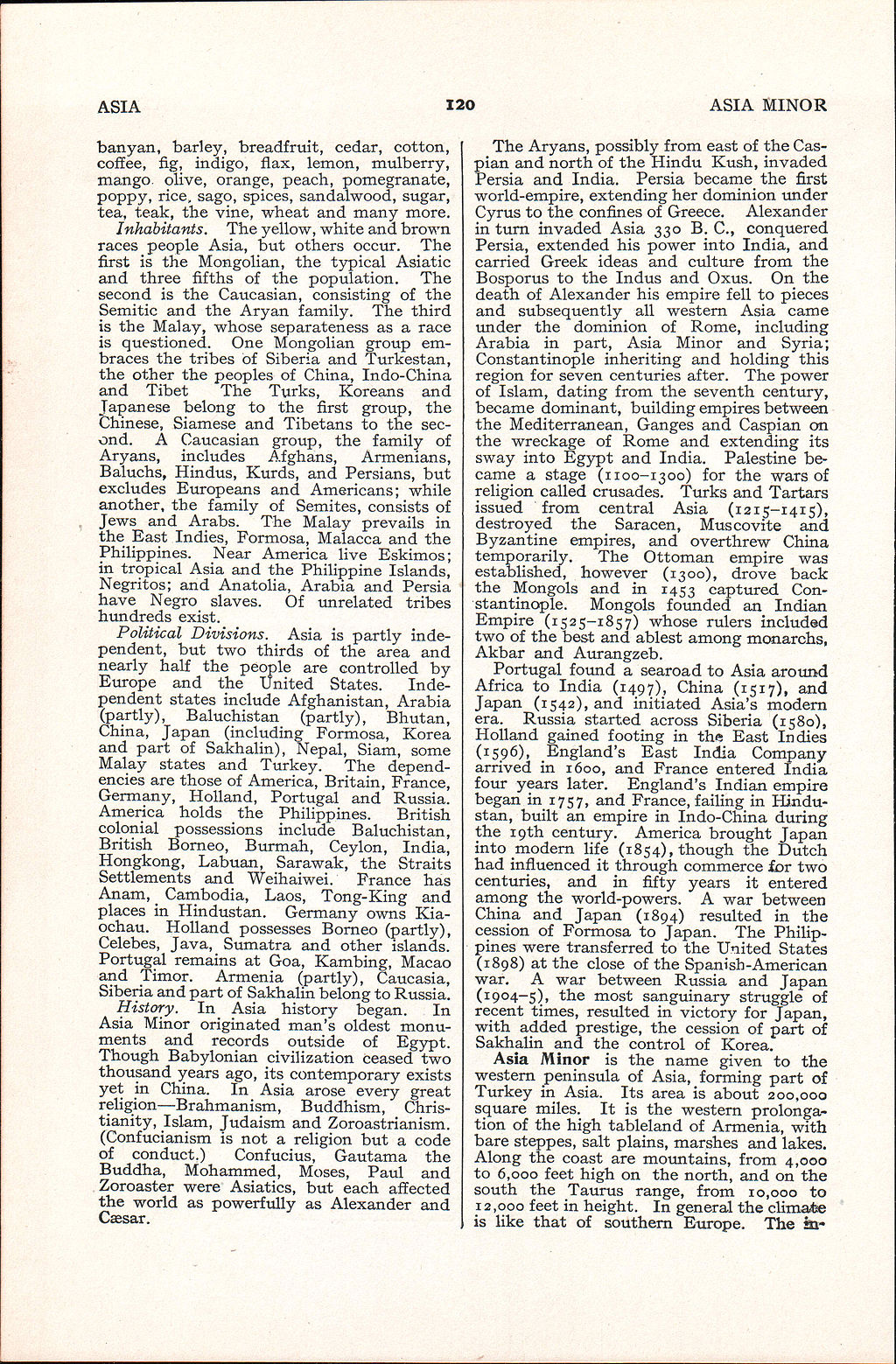banyan, barley, breadfruit, cedar, cotton, coffee, fig, indigo, flax, lemon, mulberry, mango, olive, orange, peach, pomegranate, poppy, rice, sago, spices, sandalwood, sugar, tea, teak, the vine, wheat and many more.
Inhabitants. The yellow, white and brown races people Asia, but others occur. The first is the Mongolian, the typical Asiatic and three fifths of the population. The second is the Caucasian, consisting of the Semitic and the Aryan family. The third is the Malay, whose separateness as a race is questioned. One Mongolian group embraces the tribes of Siberia and Turkestan, the other the peoples of China, Indo-China and Tibet The Turks, Koreans and Japanese belong to the first group, the thinese, Siamese and Tibetans to the second. A Caucasian group, the family of Aryans, includes Afghans, Armenians, Baluchs, Hindus, Kurds, and Persians, but excludes Europeans and Americans; while another, the family of Semites, consists of Jews and Arabs. The Malay prevails in the East Indies, Formosa, Malacca and the Philippines. Near America live Eskimos; in tropical Asia and the Philippine Islands, Negritos; and Anatolia, Arabia and Persia have Negro slaves. Of unrelated tribes hundreds exist.
Political Divisions. Asia is partly independent, but two thirds of the area and nearly half the people are controlled by Europe and the United States. Independent states include Afghanistan, Arabia (partly), Baluchistan (partly), Bhutan, China, Japan (including Formosa, Korea and part of Sakhalin), Nepal, Siam, some Malay states and Turkey. The dependencies are those of America, Britain, France, Germany, Holland, Portugal and Russia. America holds the Philippines. British colonial possessions include Baluchistan, British Borneo, Burmah, Ceylon, India, Hongkong, Labuan, Sarawak, the Straits Settlements and Weihaiwei. France has Anam, ^ Cambodia, Laos, Tong-King and places in Hindustan. Germany owns Kia-ochau. Holland possesses Borneo (partly), Celebes, Java, Sumatra and other islands. Portugal remains at Goa, Kambing, Macao and Timor. Armenia (partly), Caucasia, Siberia and part of Sakhalin belong to Russia.
History. In Asia history began. In Asia Minor originated man's oldest monuments and records outside of Egypt. Though Babylonian civilization ceased two thousand years ago, its contemporary exists yet in China. In Asia arose every great religion—Brahmanism, Buddhism, Christianity, Islam, Judaism and Zoroastrianism. (Confucianism is not a religion but a code of conduct.) Confucius, Gautama the Buddha, Mohammed, Moses, Paul and Zoroaster were Asiatics, but each affected the world as powerfully as Alexander and Caesar.
The Aryans, possibly from east of the Caspian and north of the Hindu Kush, invaded Persia and India. Persia became^the first world-empire, extending her dominion under Cyrus to the confines of Greece. Alexander in turn invaded Asia 330 B. C., conquered Persia, extended his power into India, and carried Greek ideas and culture from the Bosporus to the Indus and Oxus. On the death of Alexander his empire fell to pieces and subsequently all western Asia came under the dominion of Rome, including Arabia in part, Asia Minor and Syria; Constantinople inheriting and holding this region for seven centuries after. The power of Islam, dating from the seventh century, became dominant, building empires between the Mediterranean, Ganges and Caspian on the wreckage of Rome and extending its sway into Egypt and India. Palestine became a stage (1100-1300) for the wars of religion called crusades. Turks and Tartars issued from central Asia (1215-1415), destroyed the Saracen, Muscovite and Byzantine empires, and overthrew China temporarily. The Ottoman empire was established, however (1300), drove back the Mongols and in 1453 captured Constantinople. Mongols founded an Indian Empire (1525-1857) whose rulers included two of the best and ablest among monarchs, Akbar and Aurangzeb.
Portugal found a searoad to Asia around Africa to India (1497), China (1517), and Japan (1542), and initiated Asia's modern era. Russia started across Siberia (1580), Holland gained footing in the East Indies (1596), England's East India Company arrived in 1600, and France entered India four years later. England's Indian empire began in 1757, and France, failing in Hindustan, built an empire in Indo-China during the 19th century. America brought Japan into modern life (1854), though the Dutch had influenced it through commerce for two centuries, and in fifty years it entered among the world-powers. A war between China and Japan (1894) resulted in the cession of Formosa to Japan. The Philippines were transferred to the United States (1898) at the close of the Spanish-American war. A war between Russia and Japan (1904-5), the most sanguinary struggle of recent times, resulted in victory for Japan, with added prestige, the cession of part of Sakhalin and the control of Korea.
Asia Minor is the name given to the western peninsula of Asia, forming part of Turkey in Asia. Its area is about 200,000 square miles. It is the western prolongation of the high tableland of Armenia, with bare steppes, salt plains, marshes and lakes. Along the coast are mountains, from 4,000 to 6,000 feet high on the north, and on the south the Taurus range, from 10,000 to 12,000 feet in height. In general the climate is like that of southern Europe. The in-
